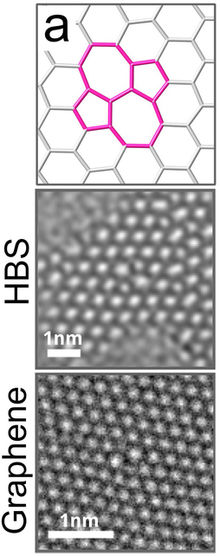A Stone–Wales defect is a crystallographic defect that involves the change of connectivity of two π-bonded carbon atoms, leading to their rotation by 90° with respect to the midpoint of their bond.[1] The reaction commonly involves conversion between a naphthalene-like structure into a fulvalene-like structure, that is, two rings that share an edge vs two separate rings that have vertices bonded to each other.



The reaction occurs on carbon nanotubes, graphene, and similar carbon frameworks, where the four adjacent six-membered rings of a pyrene-like region are changed into two five-membered rings and two seven-membered rings when the bond uniting two of the adjacent rings rotates. In these materials, the rearrangement is thought to have important implications for the thermal,[3] chemical, electrical, and mechanical properties.[4] The rearrangement is an example of a pyracyclene rearrangement.
History
editThe defect is named after Anthony Stone and David J. Wales at the University of Cambridge, who described it in a 1986 paper[5] on the isomerization of fullerenes. However, a similar defect was described much earlier by G. J. Dienes in 1952 in a paper on diffusion mechanisms in graphite[6] and later in 1969 in a paper on defects in graphite by Peter Thrower.[7] For this reason, the term Stone–Thrower–Wales defect is sometimes used.
Structural effects
editThe defects have been imaged using scanning tunneling microscopy[citation needed] and transmission electron microscopy[8] and can be determined using various vibrational spectroscopy techniques.[citation needed]
It has been proposed that the coalescence process of fullerenes or carbon nanotubes may occur through a sequence of such a rearrangements.[citation needed] The defect is thought to be responsible for nanoscale plasticity and the brittle–ductile transitions in carbon nanotubes.[citation needed]
Chemical details
editThe activation energy for the simple atomic motion that gives the bond-rotation apparent in a Stone–Wales defects is fairly high—a barrier of several electronvolts.[4][9] but various processes can create the defects at substantially lower energies than might be expected.[8]
The rearrangement creates a structure with less resonance stabilization among the sp2 atoms involved and higher strain energy in the local structure. As a result, the defect creates a region with greater chemical reactivity, including acting as a nucleophile[citation needed] and creating a preferred site for binding to hydrogen atoms.[10] The high affinity of these defects for hydrogen, coupled with the large surface area of the bulk material, might make these defects an important aspect in the use of carbon nanomaterials for hydrogen storage.[10] Incorporation of defects along a carbon-nanotube network can program a carbon-nanotube circuit to enhance the conductance along a specific path.[citation needed] In this scenario, the defects lead to a charge delocalization, which redirects an incoming electron down a given trajectory.
References
edit- ^ Brayfindley, Evangelina; Irace, Erica E.; Castro, Claire; Karney, William L. (2015). "Stone–Wales Rearrangements in Polycyclic Aromatic Hydrocarbons: A Computational Study". J. Org. Chem. 80 (8): 3825–3831. doi:10.1021/acs.joc.5b00066. PMID 25843555.
- ^ Björkman, T; Kurasch, S; Lehtinen, O; Kotakoski, J; Yazyev, O. V.; Srivastava, A; Skakalova, V; Smet, J. H.; Kaiser, U; Krasheninnikov, A. V. (2013). "Defects in bilayer silica and graphene: common trends in diverse hexagonal two-dimensional systems". Scientific Reports. 3: 3482. Bibcode:2013NatSR...3E3482B. doi:10.1038/srep03482. PMC 3863822. PMID 24336488.
- ^ Zhang, Kaiwang; Stocks, G Malcolm; Zhong, Jianxin (June 2007). "Melting and premelting of carbon nanotubes". Nanotechnology. 18 (28): 285703. Bibcode:2007Nanot..18B5703Z. doi:10.1088/0957-4484/18/28/285703. Retrieved 31 August 2021.
- ^ a b Zhou, L. G.; Shi, San-Qiang (2003). "Formation energy of Stone–Wales defects in carbon nanotubes" (PDF). Appl. Phys. Lett. 83 (6): 1222–1225. Bibcode:2003ApPhL..83.1222Z. doi:10.1063/1.1599961. hdl:10397/4230.
- ^ Stone, A. J.; Wales, D. J. (1986). "Theoretical studies of icosahedral C60 and some related structures". Chemical Physics Letters. 128 (5–6): 501–503. Bibcode:1986CPL...128..501S. doi:10.1016/0009-2614(86)80661-3.
- ^ Dienes, G. J. (1952). "Mechanism for Self‐Diffusion in Graphite". Journal of Applied Physics. 23 (11): 1194–1200. Bibcode:1952JAP....23.1194D. doi:10.1063/1.1702030. hdl:2027/mdp.39015095100155.
- ^ Thrower, P.A. (1969). "The study of defects in graphite by transmission electron microscopy". Chemistry and Physics of Carbon. 5: 217–320.
- ^ a b Kotakoski, J.; Meyer, J. C.; Kurasch, S.; Santos-Cottin, D.; Kaiser, U.; Krasheninnikov, A. V. (2011). "Stone–Wales-type transformations in carbon nanostructures driven by electron irradiation". Phys. Rev. B. 83 (24): 245420–245433. arXiv:1105.1617. Bibcode:2011PhRvB..83x5420K. doi:10.1103/PhysRevB.83.245420. S2CID 15204799.
- ^ Fowler, Patrick W.; Baker, Jon (1992). "Energetics of the Stone–Wales pyracylene transformation". J. Chem. Soc., Perkin Trans. 2 (10): 1665–1666. doi:10.1039/P29920001665.
- ^ a b Letardi, Sara; Celino, Massimo; Cleri, Fabrizio; Rosato, Vittorio (2002). "Atomic hydrogen adsorption on a Stone–Wales defect in graphite". Surface Science. 496 (1–2): 33–38. Bibcode:2002SurSc.496...33L. doi:10.1016/S0039-6028(01)01437-6.
External links
edit- Media related to Stone-Wales defect at Wikimedia Commons